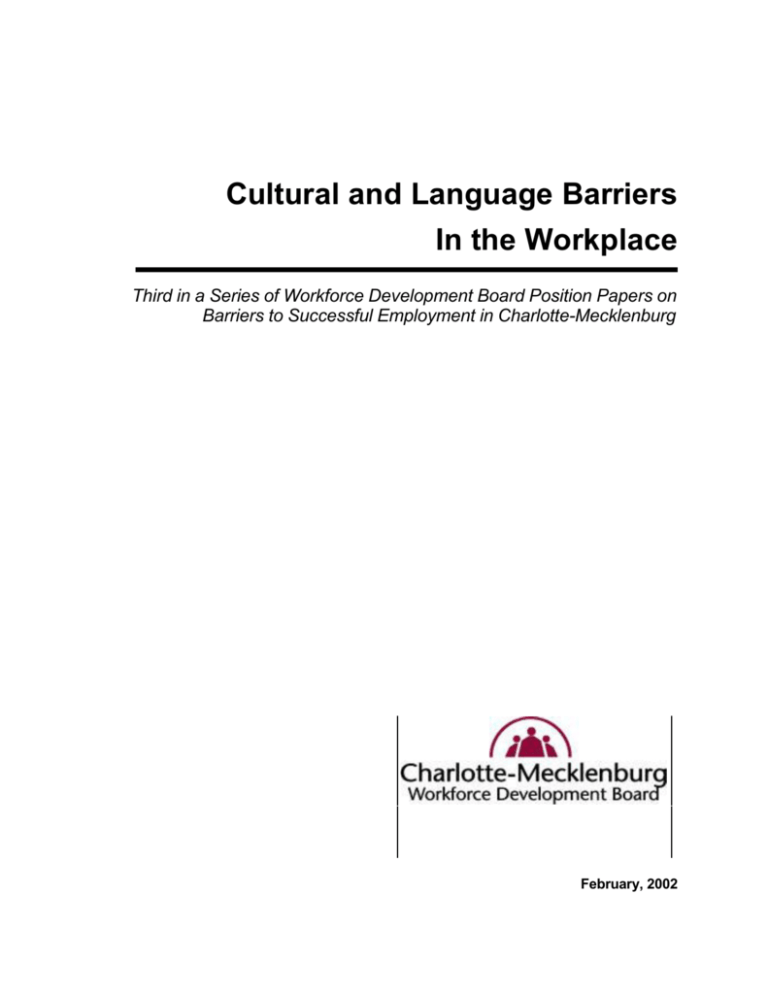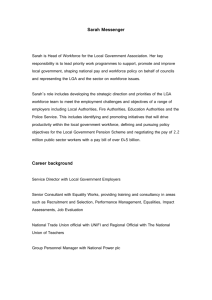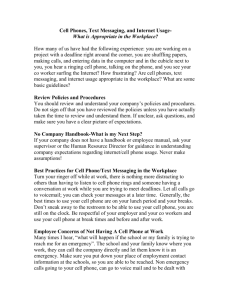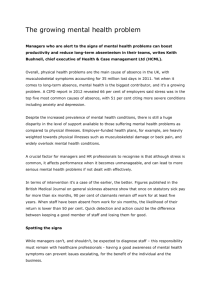Cultural and Language Barriers In the Workplace
advertisement

Cultural and Language Barriers In the Workplace Third in a Series of Workforce Development Board Position Papers on Barriers to Successful Employment in Charlotte-Mecklenburg February, 2002 Barriers to Successful Employment in Charlotte-Mecklenburg Cultural and Language Barriers in the Workplace Position of the Workforce Development Board: The Charlotte-Mecklenburg Workforce Development Board (WDB) recognizes that foreign-born workers are increasingly becoming a vital part of the community and the local workforce. The influx of immigrants into the community has provided an opportunity for employers to fill positions, particularly in the construction, service and manufacturing industries. While many foreign-born workers have assimilated into the workforce, others are more challenged to overcome cultural and language barriers that exist. The WDB believes that it is in the best interest of employers to better understand and help bridge the cultural and language divide as more foreign-born workers stream into the workforce. Being proactive in helping break down these barriers can: • Reduce costly, on-the-job accidents caused by workers not fully understanding safety rules or operational procedures; • Improve employers’ ability to recruit, hire and retain workers; and • Increase workers’ productivity. To help employers better understand language and cultural barriers in the workplace and what they can do to help their workers overcome them, the WDB has developed this position paper as part of a series of papers on barriers to successful employment in Charlotte-Mecklenburg. It provides an overview of: 1) The demographic shifts in the workforce; 2) Common language and cultural barriers; 3) Ways in which employers can help bridge the language and cultural divide; and 4) Examples of local companies that have implemented business practices that address language and cultural barriers in the workplace. . Barriers to Successful Employment in Charlotte-Mecklenburg Cultural and Language Barriers in the Workplace Prepared by Carol Morris, Planning Consultant, for the Charlotte-Mecklenburg Workforce Development Board Introduction Like other metropolitan areas around the country, Charlotte-Mecklenburg has experienced significant increases in foreign-born residents and workers over the last decade. In 1990, the U.S. Census Bureau reported that approximately 3.5% of Mecklenburg County’s population was foreign-born, or around 18,000 people. While official 2000 Census data on the foreign-born population will not be released until late 2002, preliminary Census information reveals a 162% increase in Mecklenburg County’s Asian population between 1990 and 2000 and a 570% increase in the Hispanic/Latino population. Together, these two population segments accounted for more than one-quarter (28.2%) of the county’s overall population growth during the decade. Immigrants from other regions of the world are also rising in number, further diversifying Charlotte-Mecklenburg’s population. According to the 2000 Census, approximately 21,000 nonHispanic or Asian immigrants were living in Mecklenburg County in 2000. CharlotteMecklenburg Schools reports that over 84 languages are now spoken within the international student population. The Census Bureau projects we will continue to see increases in our foreign-born population over the next several decades, particularly Hispanic/Latino residents. The number of new Hispanic residents is expected to increase at a rate of 10 million people every 10 years nationwide. According to the Bureau, the western states will likely see the largest increases, followed by south and southeastern states. (North Carolina currently ranks 9th among all states in the number of Mexican-born residents.) The influx of immigrants into Charlotte-Mecklenburg and the region has created an opportunity for local employers to help fill gaps in the labor market, particularly in the service, manufacturing and construction industries. Many local companies such as T.J. Maxx, Harris Teeter, Wilton Connor Packaging, BB and T, and the Lance Corporation have increasingly hired international workers to meet their workforce needs and demands. Among other positive responses, these companies report that immigrant workers are often more motivated and have a stronger work ethic than others in the workforce. Hiring immigrant workers has also allowed businesses to add an international flavor to their workplaces, especially important for companies tied to the global economy and/or serving a more diverse local customer base. Many immigrant workers have little or no problems assimilating into the American workplace. They speak English well and understand the business and social culture and climate. However, others find it more challenging. With the melting pot of workers streaming into the workforce, it is important for employers to understand the many cultural differences and nuances of immigrant workers so they can help them assimilate faster. Americans are often quick to assume that “everyone thinks like we do” and that people from other places should just naturally acclimate. 2 Barriers to Successful Employment in Charlotte-Mecklenburg The reality is that language and cultural barriers and misunderstandings can get in the way of effective communication and create complications in the workplace, including problems with safety. Attitudinal barriers, biases and stereotyping by co-workers, supervisors and managers can hinder the ability of a business to recruit and successfully employ immigrant workers. In addition, systemic barriers such as employment policies, practices and systems can have an adverse affect on certain groups. For example, some companies require certain education credentials with no consideration given to equivalent combinations of education and experience, thus eliminating otherwise qualified applicants from the potential labor pool. A surprisingly large number of immigrants, particularly refugees, have considerable education and experience in their native country, but because of their limited English speaking abilities and their cultural differences, their credentials and experience may not be recognized. A human resource manager at T. J. Maxx reports that she discovered that one of the Vietnamese workers in the company’s distribution center was a lawyer before coming to the U.S. Because ethnic diversity is part of the new reality of the American workplace, it is important for the business community, workforce educators, trainers and other human resource professionals to gain a better understanding of and sensitivity to language barriers and cultural differences among workers from all backgrounds. Such understanding and sensitivity will help employers increase recruitment, hiring, retention and advancement of immigrant workers. Ultimately, it will help businesses remain competitive by maintaining a stable, productive and safe workforce. This paper identifies some of the common barriers and breakdowns between employers and immigrant workers and offers tips for businesses to consider in helping to overcome some of these challenges. It also provides some examples of national and local businesses that have successfully integrated workers from different cultures and backgrounds into their workplaces. Common Cultural and Language Barriers Human resource professionals who have helped immigrants obtain jobs and who have worked with companies to build better relationships with immigrant employees have identified some of the common cultural differences and misunderstandings that often show up in the workplace. Some examples of these are: • Roles and Status: In some cultures, a social hierarchy often exists that can create “bumps” in communication in the workplace. For example, in many countries, women are subordinate to men. Working in an American business, women from these countries may feel they should defer to their male counterparts or should not speak to or even look directly in the eyes of their male supervisors, managers or co-workers. When men innocently try to interact with them in the workplace, such women can feel uncomfortable or violated in some way. In contrast, males with such cultural backgrounds may not adapt well to working equally with females or having female supervisors. Understanding the interaction between sexes and the roles assigned in various cultures is important. • Personal Space: Americans typically prefer to stand about five feet a part when conversing. However, people from different cultural backgrounds may have different “comfort zones”. For example, Germans and Japanese like more distance, and Arab and 3 Barriers to Successful Employment in Charlotte-Mecklenburg Latinos generally like to get closer. Knowing these nuances in personal space can help communications tremendously. • Body Language: Body language says a lot, but it can be interpreted differently in the world. For example, most Americans typically signal “no” in shaking their heads, but people from some countries raise their chins. Another example is with eye contact. Americans like to make eye contact, and when it does not happen it can be taken as a sign of evasiveness. In some Latin and Asian countries, however, averted eyes are a sign of respect. Similarly, people from some cultures do not feel comfortable shaking hands. An American worker or manager may view this as lack of respect or ignorance. • Religion: In many cultures, religion dominates life in a way that is often difficult for Americans to understand. For example, workers from some Muslim cultures may want to pray three times a day in accordance with their values and beliefs. There may also be religious holidays on which people of certain religions are forbidden to work or need to follow certain customs. These differences need to be respected, where possible, and not ignored. • Personal Appearance: Hygiene and grooming, eating habits and attire can vary from country to country and culture to culture. For example, some people may wear attire such as a headdress as part of their custom and beliefs. To remain true to their beliefs, some workers may want to continue to wear this dress in the American workplace. Employers may view this as inappropriate or unsafe. It is particularly problematic in businesses in which workers wear uniforms. In another example, immigrants from India, Turkey or other countries may use spices in their diets that are emitted through the body. American workers can interpret this as dirty or unhygienic, which is not the case. Other cultural nuances exist. However, with the increasing number of nationalities in the workforce, it is impossible to identify all of the potential cultural differences. Many resources are available to help employers learn more about specific cultures if they are so inclined. Language barriers often go hand-in hand with cultural differences, posing additional problems and misunderstandings in the workplace. When a person speaks little English, he/she can be intimidated and frustrated trying to communicate with English-speaking supervisors or coworkers and visa versa. Workers may act like they know what is being said, but in fact, may not know. In some jobs, this can be dangerous. A recent Business Journal article on the rising number of Hispanic workers in Charlotte-Mecklenburg’s construction industry pointed out that workers who speak little or no English are at much greater risk of having an accident on the job because of not having a full grasp of safety standards. On-site training is available through the Carolinas Associated General Contractors (AGC) to help bridge the language barrier and improve safety conditions. But according to the AGC, some local contractors are taking advantage of this training and many others have assumed the “let’s do nothing until we are forced to” attitude, which could prove expensive considering the high costs of on-the-job injuries or deaths. 4 Barriers to Successful Employment in Charlotte-Mecklenburg All language barriers may not have such dire consequences, but they can contribute to a lack of productivity, mistakes being made or general lack of trust between the employer and workers, all of which could be avoided if communication were clearer. Even if workers can speak English fairly well, the lingo, slang or jargon that is commonly used by Americans or is specific to different industries can create difficulties for foreign workers. For example, someone not familiar with the expression could easily misinterpret the term “off the top of my head”. Another example comes from a South African worker who indicated she was terribly confused when she heard someone say he was wearing a toboggan. She was trying to visualize this person with a sled on his head. We take it for granted that everyone knows what we are talking about. Not knowing these terms does not imply a person isn’t smart or capable, but that he/she simply may not have learned the words or jargon that are commonly used by others on the job or in everyday conversation. How Employers Can Help Bridge the Cultural Divide in the Workplace Clearly it is the responsibility of immigrant workers to learn English and adapt to the cultural norms in the American workplace. However, this can take time. Employers have much to gain from helping their workers bridge the cultural divide. All too many employers have the “sink or swim” attitude, expecting immigrant workers to figure things out for themselves, which doesn’t work in many cases. Nor is it a wise business decision. The benefits to employers of investing time and resources in helping immigrant workers adapt to the workplace include increased productivity and performance, greater trust and loyalty among workers and improved safety. This can translate into higher business profits in the long run. Human resource professionals offer the following tips or suggestions for employers who want to strengthen and retain their immigrant workforce. • Learn as much as you can about the culture of the people you are dealing with, particularly if you employ several people from the same cultural background. • Recognize the broad ethnic diversity that exists within groups such as Hispanics or Asians. Don’t assume everyone shares common cultural backgrounds or languages just because they came from the same region of the world. Someone labeled “Hispanic” may come from the mountains of Chili, a large Central American city or a rural village in Mexico. The same is true for immigrants from the many different Asian countries where cultures and languages vary widely. • Respect individual differences, abilities and personalities. Even though people may share a common language or culture, it doesn’t mean they are alike, any more than all Americans are alike. Stereotyping discounts individuals and can limit options for them in the workplace. Getting to know a person’s culture is a first step to getting to know them as individuals. 5 Barriers to Successful Employment in Charlotte-Mecklenburg • • Provide an orientation program for new hires that addresses some of the cultural differences and language barriers . This can help head off confusing or potentially unpleasant experiences for international employees. Consider having co-workers serve as mentors or coaches to help new workers adapt to the culture and vocabulary of the workplace. • When working with immigrants, refrain from using jargon or slang that might not translate well. Choose words that convey the most specific meaning and stick to one topic at a time. • When training immigrant employees, make sure they understand your training material and why it is useful to them. Use graphics or demonstrations to illustrate points whenever possible. Often the lack of effective training tools and qualified instructors can leave immigrant workers out of the training loop and limit their opportunities to enhance their skills and advance in the workplace. • Never assume your communications with someone with limited English-speaking abilities has been understood. Ask for feedback or for demonstration, particularly when you are training them. • Be patient. A thoughtful supervisor or co-worker can make all the difference in helping prevent feelings of inadequacy and embarrassment when a person cannot express him or herself clearly or fully. • Recruit bilingual managers and supervisors to serve as the communication link between cultures and/or engage co-workers to serve as translators while people are learning English. • If you have a number of people in need of learning English, consider partnering with Central Piedmont Community College to offer an on-site English As A Second Language (ESL) class that can be taught during the lunch hour or other times during the day. To do so, it is important to create a safe environment for learning. Helping people learn English is a way to build trust and loyalty. • Help workers take care of their basic survival needs . For example, helping them find transportation to and from work can reduce fears of the unknown and build trust and loyalty with the worker. Companies such as T. J. Maxx and Wilton Connor Packaging have contracted with the City of Charlotte to provide vanpool vans to transport a group of immigrant workers to and from work at little cost to the companies or the workers. Other ways to help may include assisting workers establish credit or file income tax returns, which can seem to be monumental tasks for someone who doesn’t know the system. • Provide sensitivity training to native workers in the company to make them more aware of and sensitive toward the different cultural differences. 6 Barriers to Successful Employment in Charlotte-Mecklenburg • Promote immigrants when appropriate, not only to give people more opportunities, but to show other immigrants that they can advance if they prove themselves. • Keep current on immigration regulations to make sure proper employment forms are completed and maintained. Get a copy of the INS Handbook for Employers if you don’t have one. Local Business Examples The following are examples of how some local companies are addressing language and cultural barriers in their places of business. It is clear from these examples that companies are recognizing the value and necessity of helping employees deal with the language and cultural challenge. • T.J. Maxx T. J. Maxx is one of the best local examples of a company that goes out of its way to help its foreign workforce deal with language and cultural barriers. International workers comprise approximately 50% of the company’s workforce at its local distribution center on Carowinds Boulevard. The company employs around 850 hourly employees on three different shifts. According to company human resource staff, 25 countries are represented in this workforce, with Asians and Latinos in the majority. Helping its foreign workers assimilate is an important and essential part of the T.J. Maxx corporate culture. When first hired, foreign speaking employers are provided on-the-job coaching from bilingual employees for a period of two to six weeks, until the new employees can function on their own. In addition, training material provided to new workers is bilingual. The company also offers on-site, English as a Second Language Classes (ESL) for employees who want to improve their language skills. Beginner, intermediate and advanced classes are offered through a partnership with Central Piedmont Community College. Classes are offered during the lunch hours twice a week. The company pays for all the supplies and books and a portion of the teacher’s salary. Bilingual supervisors help bridge the language and cultural divide. Approximately four Latin and four Asian supervisors are employed at the company. In addition, a bilingual recruiter has been hired to help attract foreign workers and facilitate the hiring process. The company also sponsors lunch and learn activities to help workers get to know each other and the different cultures. And because many of the foreign-born workers do not have their own transportation, the company has contracted with the City of Charlotte to provide five 15-passenger vans for employees to use as part of the City’s van-pool program. T. J. Maxx relies on its international workers to meet the company’s workforce needs and production demands. From its experience in hiring foreign-born workers, the retailer indicates that it has very little attrition with this population of workers, which is 7 Barriers to Successful Employment in Charlotte-Mecklenburg unusual, particularly for entry-level positions. Company loyalty and moral among these workers is high, and many of the workers recruit others from their cultures to also become T. J. Maxx employees. Providing such incentives and support for foreign-born workers has proven to be a prudent business investment for the company. Some of the challenges cited by human resource staff include finding bilingual supervisors and providing ESL classes for third shift workers. • Wilton Connor Packaging Nationally recognized for its progressive employee programs, Wilton Connor Packaging has done much to attract foreign-born workers and help them overcome barriers to successful employment. Of its 650 employees, approximately 75% are Hispanic/Latino and 10% are Asian. In addition to providing childcare benefits, an on-site laundry service, a handy-man service and access to vans through the City of Charlotte van pool program, the company offers its employers both on-site Spanish and English classes. Wilton Connor relies heavily on its bi-lingual supervisors to help bridge language and cultural gaps. In line with some of its other c policies and benefits, the company also helps its foreign-born workers establish accounts at a local credit union, recognizing that many of these workers do not have bank accounts, which can make them vulnerable to theft. Because of its tremendous human resource offerings, Wilton Connor boasts less than a 2% turnover rate among its employees. • The Kip Corporation The Kip Corporation is a local construction company that employs around 70 people. Forty percent of its employees are Hispanics, primarily Mexicans. Having Spanish speaking foremen has been essential to the company’s success. These foremen provide instructions to non-English speaking workers and are able to determine their actual skill levels. In addition, all printed information that is given to workers is provided in both Spanish and English. The company has generally had good success in retaining workers, pointing out that the workers have a strong work ethic and typically do not have problems with drug use. • Harris Teeter Harris Teeter has increasingly been hiring foreign-born workers at its distribution center and grocery stores in the region. The majority are Latinos. Employees with limited English skills are placed into positions that have not direct contact with customers. As employees improve their skills, they are able to move up in the company to positions that deal directly with the public. Spanish classes are offered to management, but are optional. Orientation and management training addresses the culture of foreign-born workers so they can better understand employees. The company reports that its investment in foreign-born employees has been worthwhile, giving the company another avenue of recruitment in a tight labor market. The main challenge Harris Teeter has experienced in hiring immigrant workers has been dealing with employee documentation issues and the need for all employees to have social security numbers. 8 Barriers to Successful Employment in Charlotte-Mecklenburg • Woonsocket Spinning Woonsocket is one of the few remaining woolen mills remaining in the United States. It employs approximately 100 workers, 15 of whom are foreign-born. The majority of its foreign-born workers are Asians. Overcoming language barriers is the greatest challenge for both workers and the employer. To help with this, the company hires interpreters or has other employees who speak the language help the non-English speaking employees, particularly during orientation and training. The company has found its efforts to help bridge language barriers worth the investment, reporting that its foreign-born workers are dependable and good, loyal employees. They also bring production skills that the company is unable to find elsewhere. As a point of advice for other companies considering hiring immigrant workers, Woonsocket underscores the need for patience in working with employees, but suggests there will be a payoff. • UPS UPS in Charlotte has a diverse group of foreign-born employees. The company offers Spanish classes to it supervisors and managers and will soon be offering ESL classes to its workers who have limited English speaking abilities. While the company does not have specific initiatives to help its immigrant workers deal with challenges in their personal lives such as finding housing or navigating the system of services that are available, it does link its employers to the United Way which UPS supports. Currently the company does not have special diversity and cultural training for its supervisors, but is contemplating adding such training in the future. The company indicates that having foreign-born workers as part of its workforce is important for the company which is definitely tied to the global economy. • Sheraton Corporation Approximately 22% of the Sheraton Corporation’s workforce is Hispanic, primarily Mexicans. Language is the main barrier. To help its employers deal with the language challenge, the company has bilingual employees serve as translators and mentors. In addition, all printed material is provided in Spanish and English and the company makes every effort to take the particular traditions of the Spanish/Mexican culture into account when planning employee holiday events. The company reports that its investment in Hispanic workers has been a good one. 9 Barriers to Successful Employment in Charlotte-Mecklenburg Local Resources for Employers Employers interested in learning more about hiring and working successfully with immigrant workers have a number of resources available to them for language, cross-cultural training, interpretation and other services. These include: Central Piedmont Community College International Program (704) 330-6484/6838 Worksite Basic Skills Programs (704) 330-4554 Local businesses identified by the International House and City of Charlotte International Cabinet for cross-cultural training and/or interpretation. CulturLink (704-544-7878 Institute for Language and Culture (704) 321-0452 Nathan Feldman and Associates (704) 365-2860 Program Esperanza (through Catholic Social Services) (704) 370-3248 The Spanish Center for Business and Language (704) 347-5882 Translation Services International (704) 347-5882 Choice Translating Services (704) 717-0043 Carolina Interpreting and Consulting Services (704) 532-7446 Carolina Polygot Translators (704) 336-5781 Accurate Translation Services (704) 568-8744 Carolina Associated General Contractors for safety training (704) 372-1450 www.cagc.org Sources Anthony Griffin, “Overcoming Cultural and Language Barriers in Facilitation and Training”, Facilitation News, Vol. 5, No. 2. Barbara Thiede, “Push for Greater Safety Stymied By Language Barrier”, The Business Journal, August 17, 2001. Brian K. Linhardt, Hiring and Managing a Culturally Diverse Workforce: No Prescriptions Please”, Labor Management Decisions, Summer-Fall, 1997. Carla Johnson, “Cultural Sensitivity Makes Good Business Sense”, HR Magazine, November, 1995. Sondra Thiederman, Bridging Cultural Barriers for Corporate Success: How to Manage the Multicultural Work Force, Lexington Books, 1991. U.S. Census Bureau, “Foreign-Born Population in the United States”, March 2000. 10








